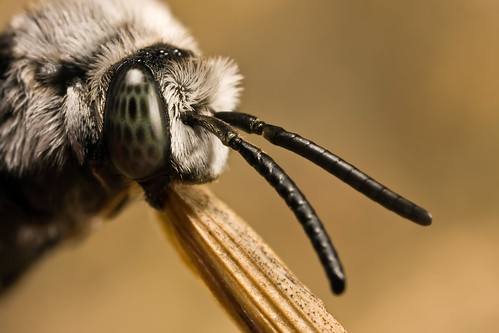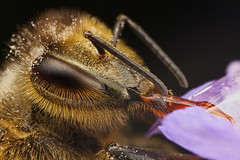I was recently asked by someone who had just bought Canon's 100mm macro about the settings that I use. Here's my response:
Hey Chris,
Some of the setting info you asked for does come with experience -and it really depends on your shooting style. But here's what I use, and keep in mind that I don't use a tripod or a monopod.
For closeup photography (1/4 to 3/4 life size):
Shutter priority 1/400 with the ISO set to 200 - 800 depending on what aperture I'm getting with that shutter speed. I try to shoot no lower than F5.6. Normally I'm in shutter priority if I'm trying to freeze a little subject motion.
Aperture priority F5.6 to F8 with the ISO set to 200 - 800 depending on the shutter speed I get with the aperture setting. I try to keep the shutter speed at twice the 1/focal length rule. So if I was shooting with the 100mm I'd want my shutter to be no lower than 1/200. Great for when I'm trying to control the depth and there is little to no movement in the scene.
A flash can be used for both of those settings for fill light to bring out more detail in the subject, but set the flash to -1 1/3 to -2 FEC and diffuse it. You want just enough light to fill in the shadows a little, but not so much that the resulting image looks like it was taken with a flash...
For macro:
With few exceptions (like low depth of field flower shots) I shoot in manual mode F11, 1/250 (the max sync speed of the Canon 40D) and ISO 100. At those settings when shooting at life size or higher magnification that flash will be the only significant source of light in the scene so the shutter speed is irrelevant -the duration of the flash is your shutter. the key to getting sharp images when shooting macro is to diffuse the flash and get it as close to the subject as possible. The closer the flash is to what you are shooting the shorter the flash duration will be -your "virtual shutter" speed will be extremely fast and you can freeze a lot of motion.
Any flash will do -just get it off of the camera and out toward the end of the lens. If you get a macro flash then I'd recommend the MT-24EX over the MR-14EX simply because the MR-14EX's flash heads are too close to the plane of the lens -getting good shadows, even with ratio control, is difficult. Using the flash mount that Canon supplies with the MT-24EX you can get the flash heads far enough from the lens plane to get good shadows and once you find a way to diffuse it (plastic from a milk jug works wonders) you'll get some really good light. I've never tried it, but you could also cut up a Lumiquest Soft Screen and use it as a diffuser.
Monday, June 23, 2008
Monday, June 16, 2008
Changes in my Gear
Just a quick note to let everyone know that I'm still here (been busy!) and that I've made some changes to the gear that I use. First up is the MT-24EX -I'm no longer using Gary Fong's Puffer diffuser. I contacted a company that makes diffusion plastics and they sent me a sales brochure with a sample of every plastic that they make. I took small strips of one of them and hot glued it directly to my MT-24EX's flash heads. Life size to twice life size is the toughest magnification range for me to shoot in and get good diffusion -past 2x the flash heads are so close to he subject that the apparent size of the flash relative to the subject makes getting good diffusion easy. So I'm including a life size shot with this post as an example of what I've been able to do with the new material. Here's a 3x shot so you can see how good the detail is -and how little glare I'm getting.

Also notice that the shadows are much more pronounced. One of the problems with using the Puffer is it's shape -that curve throws light everywhere. I've been able to get shadows with it simply because of the way I would place the flash heads on the mount, but the shadows were always "thin". With a flat diffuser the light from each flash head is a lot more directional so shadows look better, and are easier to control. As an added bonus the new material only causes me to lose about 2/3 of a stop so the flash duration is extremely low.
Several people have asked me if I use a tripod. The only time I use any kind of camera support is when I'm shooting water drops or abstracts in the house -out in the field I take every shot hand held. I'm not using any kind of brace other than an elbow on a knee. For both of the images in this post (and a lot of my recent shots) I'm holding on to whatever the critter is perching on with my left hand and I'm bracing the lens on that same hand to keep everything steady.
Now that it's "macro season" here I'll try to do more image deconstructions as a way to show you how I'm taking photos and hopefully you can pick up something from it that you can apply to your own style.
Happy shooting!

Also notice that the shadows are much more pronounced. One of the problems with using the Puffer is it's shape -that curve throws light everywhere. I've been able to get shadows with it simply because of the way I would place the flash heads on the mount, but the shadows were always "thin". With a flat diffuser the light from each flash head is a lot more directional so shadows look better, and are easier to control. As an added bonus the new material only causes me to lose about 2/3 of a stop so the flash duration is extremely low.
Several people have asked me if I use a tripod. The only time I use any kind of camera support is when I'm shooting water drops or abstracts in the house -out in the field I take every shot hand held. I'm not using any kind of brace other than an elbow on a knee. For both of the images in this post (and a lot of my recent shots) I'm holding on to whatever the critter is perching on with my left hand and I'm bracing the lens on that same hand to keep everything steady.
Now that it's "macro season" here I'll try to do more image deconstructions as a way to show you how I'm taking photos and hopefully you can pick up something from it that you can apply to your own style.
Happy shooting!
Thursday, June 5, 2008
How Working Distance Works Against You
I’ve been putting a little money aside for a while so I could pick up some new gear. Photography isn’t what I do for a living and with a wife and three kids I just can’t spend money on stuff that doesn’t help pay for the important things like electricity and food. But I managed to get in range of the Canon 180mm L macro and thought about finally getting it…
Over the course of this past weekend I talked myself out of spending the money –the 180L just won’t allow me to do anything that I’m not currently doing with the glass that I have and I don’t need the extra reach. In fact putting more distance between me and the subject could actually be detrimental. Take the shot I’ve included with this post, shot at three times life size with a Canon MPE-65mm lens. The only way I could get a sharp image of that honeybee was to hold on to the flower that it was feeding on. So with the flower’s stem pinched between my left index finger and thumb I rested the lens on my left hand and adjusted the focus by sliding the lens back and forth. Since the lens and the subject were on the same platform, my hand, I could keep the scene rock solid and take full control over where I placed the depth of field. Now imagine that same shot with a 180mm lens and two teleconverters (a 1.4x and a 2x) for 2.8x at a nine inch working distance.
I’d have to rest that bazooka of a lens on my forearm and try to shoot over the ridge of my thumb…
It’s not possible to take a shot of an insect on a flower without holding on to the stem –the slightest breeze is enough to throw the critter out of the plane of sharp focus. The best way to get a sharp, well composed image is to take full control of the scene and I just can’t do that by standing back with a long focal length lens. The 180L will have to wait for another day…
Over the course of this past weekend I talked myself out of spending the money –the 180L just won’t allow me to do anything that I’m not currently doing with the glass that I have and I don’t need the extra reach. In fact putting more distance between me and the subject could actually be detrimental. Take the shot I’ve included with this post, shot at three times life size with a Canon MPE-65mm lens. The only way I could get a sharp image of that honeybee was to hold on to the flower that it was feeding on. So with the flower’s stem pinched between my left index finger and thumb I rested the lens on my left hand and adjusted the focus by sliding the lens back and forth. Since the lens and the subject were on the same platform, my hand, I could keep the scene rock solid and take full control over where I placed the depth of field. Now imagine that same shot with a 180mm lens and two teleconverters (a 1.4x and a 2x) for 2.8x at a nine inch working distance.
I’d have to rest that bazooka of a lens on my forearm and try to shoot over the ridge of my thumb…
It’s not possible to take a shot of an insect on a flower without holding on to the stem –the slightest breeze is enough to throw the critter out of the plane of sharp focus. The best way to get a sharp, well composed image is to take full control of the scene and I just can’t do that by standing back with a long focal length lens. The 180L will have to wait for another day…
Subscribe to:
Comments (Atom)



